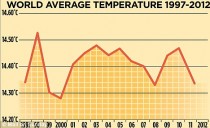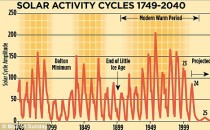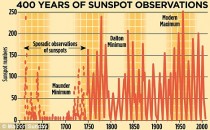In an attempt to counter the scientific argument made in the editorial in the WSJ this weekend by distinquised scientists, the usual suspects of men and women who have abused the scientific method and taken advantage of the considerable largess (tens of billions of grant dollars available for those willing to sell their souls to the devil) responded with a response as weak and laughable as their excuses for the ever growing lists of fialure for their theory. They use their favorite talking points including the parallel to tobacco and of course the call to authority (basically their own bad work that got by a failed pal review process). There is not a one on that list I would trust with any advice or accurate information about climate science. The mindless herd keeps doubling down on proven deceptions. They even went as far as using the bogus 97% survey which ended up asking 79 scientists if it has warmed since the little ice age and making their answer proof of a settled science. Despicable. I look forward to the day in the not to distant future when these men and women are called to answer for their sins against science. Here is an excerpt from the letter and the list of accomplices.
Do you consult your dentist about your heart condition? In science, as in any area, reputations are based on knowledge and expertise in a field and on published, peer-reviewed work. If you need surgery, you want a highly experienced expert in the field who has done a large number of the proposed operations.
You published “No Need to Panic About Global Warming” (op-ed, Jan. 27) on climate change by the climate-science equivalent of dentists practicing cardiology. While accomplished in their own fields, most of these authors have no expertise in climate science. The few authors who have such expertise are known to have extreme views that are out of step with nearly every other climate expert. This happens in nearly every field of science. For example, there is a retrovirus expert who does not accept that HIV causes AIDS. And it is instructive to recall that a few scientists continued to state that smoking did not cause cancer, long after that was settled science.
Climate experts know that the long-term warming trend has not abated in the past decade. In fact, it was the warmest decade on record. Observations show unequivocally that our planet is getting hotter. And computer models have recently shown that during periods when there is a smaller increase of surface temperatures, warming is occurring elsewhere in the climate system, typically in the deep ocean. Such periods are a relatively common climate phenomenon, are consistent with our physical understanding of how the climate system works, and certainly do not invalidate our understanding of human-induced warming or the models used to simulate that warming.
Thus, climate experts also know what one of us, Kevin Trenberth, actually meant by the out-of-context, misrepresented quote used in the op-ed. Mr. Trenberth was lamenting the inadequacy of observing systems to fully monitor warming trends in the deep ocean and other aspects of the short-term variations that always occur, together with the long-term human-induced warming trend.
The National Academy of Sciences of the U.S. (set up by President Abraham Lincoln to advise on scientific issues), as well as major national academies of science around the world and every other authoritative body of scientists active in climate research have stated that the science is clear: The world is heating up and humans are primarily responsible. Impacts are already apparent and will increase. Reducing future impacts will require significant reductions in emissions of heat-trapping gases.
Research shows that more than 97% of scientists actively publishing in the field agree that climate change is real and human caused. It would be an act of recklessness for any political leader to disregard the weight of evidence and ignore the enormous risks that climate change clearly poses. In addition, there is very clear evidence that investing in the transition to a low-carbon economy will not only allow the world to avoid the worst risks of climate change, but could also drive decades of economic growth. Just what the doctor ordered.
Kevin Trenberth, Sc.D.
Distinguished Senior Scientist
Climate Analysis Section National Center for Atmospheric Research
La Jolla, Calif.
Kevin Trenberth, Sc.D, Distinguished Senior Scientist, Climate Analysis Section, National Center for Atmospheric Research
Richard Somerville, Ph.D., Distinguished Professor, Scripps Institution of Oceanography, University of California, San Diego
Katharine Hayhoe, Ph.D., Director, Climate Science Center, Texas Tech University
Rasmus Benestad, Ph.D., Senior Scientist, The Norwegian Meteorological Institute
Gerald Meehl, Ph.D., Senior Scientist, Climate and Global Dynamics Division, National Center for Atmospheric Research
Michael Oppenheimer, Ph.D., Professor of Geosciences; Director, Program in Science, Technology and Environmental Policy, Princeton University
Peter Gleick, Ph.D., co-founder and president, Pacific Institute for Studies in Development, Environment, and Security
Michael C. MacCracken, Ph.D., Chief Scientist, Climate Institute, Washington
Michael Mann, Ph.D., Director, Earth System Science Center, Pennsylvania State University
Steven Running, Ph.D., Professor, Director, Numerical Terradynamic Simulation Group, University of Montana
Robert Corell, Ph.D., Chair, Arctic Climate Impact Assessment; Principal, Global Environment Technology Foundation
Dennis Ojima, Ph.D., Professor, Senior Research Scientist, and Head of the Dept. of Interior’s Climate Science Center at Colorado State University
Josh Willis, Ph.D., Climate Scientist, NASA’s Jet Propulsion Laboratory
Matthew England, Ph.D., Professor, Joint Director of the Climate Change Research Centre, University of New South Wales, Australia
Ken Caldeira, Ph.D., Atmospheric Scientist, Dept. of Global Ecology, Carnegie Institution
Warren Washington, Ph.D., Senior Scientist, National Center for Atmospheric Research
Terry L. Root, Ph.D., Senior Fellow, Woods Institute for the Environment, Stanford University
David Karoly, Ph.D., ARC Federation Fellow and Professor, University of Melbourne, Australia
Jeffrey Kiehl, Ph.D., Senior Scientist, Climate and Global Dynamics Division, National Center for Atmospheric Research
Donald Wuebbles, Ph.D., Professor of Atmospheric Sciences, University of Illinois
Camille Parmesan, Ph.D., Professor of Biology, University of Texas; Professor of Global Change Biology, Marine Institute, University of Plymouth, UK
Simon Donner, Ph.D., Assistant Professor, Department of Geography, University of British Columbia, Canada
Barrett N. Rock, Ph.D., Professor, Complex Systems Research Center and Department of Natural Resources, University of New Hampshire
David Griggs, Ph.D., Professor and Director, Monash Sustainability Institute, Monash University, Australia
Roger N. Jones, Ph.D., Professor, Professorial Research Fellow, Centre for Strategic Economic Studies, Victoria University, Australia
William L. Chameides, Ph.D., Dean and Professor, School of the Environment, Duke University
Gary Yohe, Ph.D., Professor, Economics and Environmental Studies, Wesleyan University, CT
Robert Watson, Ph.D., Chief Scientific Advisor to the UK Department of Environment, Food and Rural Affairs; Chair of Environmental Sciences, University of East Anglia
Steven Sherwood, Ph.D., Director, Climate Change Research Centre, University of New South Wales, Sydney, Australia
Chris Rapley, Ph.D., Professor of Climate Science, University College London, UK
Joan Kleypas, Ph.D., Scientist, Climate and Global Dynamics Division, National Center for Atmospheric Research
James J. McCarthy, Ph.D., Professor of Biological Oceanography, Harvard University
Stefan Rahmstorf, Ph.D., Professor of Physics of the Oceans, Potsdam University, Germany
Julia Cole, Ph.D., Professor, Geosciences and Atmospheric Sciences, University of Arizona
William H. Schlesinger, Ph.D., President, Cary Institute of Ecosystem Studies
Jonathan Overpeck, Ph.D., Professor of Geosciences and Atmospheric Sciences, University of Arizona
Eric Rignot, Ph.D., Senior Research Scientist, NASA’s Jet Propulsion Laboratory; Professor of Earth System Science, University of California, Irvine
Wolfgang Cramer, Professor of Global Ecology, Mediterranean Institute for Biodiversity and Ecology, CNRS, Aix-en-Provence, France
by Ed Berry
In a precedent-making decision, the Montana Supreme Court dismissed yesterday the Petition for Original Jurisdiction by Our Children’s Trust saying unsettled factual issues related to limiting emissions of greenhouse gasses (GHGs) must first be addressed in a lower court.The Montana Supreme Court followed the recommendations of the Montana Attorney General, and rejected the claim made by Our Children’s Trust in its May 4, 2011, Petition, that a “scientific consensus exists that increasing emissions of greenhouse gases (GHG) are affecting the Earth’s climate.” The ruling forces those filing future GHG-emissions lawsuits to first prove the scientific credibility of their global warming claims by means of legally competent evidence.
As the Montana Supreme Court stated the case:
Petitioners ask us to enter judgment in this original proceeding to declare that the State of Montana (State) holds the atmosphere in trust for the present and future citizens of the State of Montana. Petitioners further contend that this trust imposes on the State the affirmative duty to protect and preserve the atmosphere, including establishing and enforcing limitations on the levels of greenhouse gas emissions as necessary to mitigate human-caused climate change.
But, the Court wrote, it was “persuaded” by the Attorney General’s arguments that the evidence Our Children’s Trust offered for human-caused global warming is in legally substantial doubt:
This disputed record is just one example of the factual determinations this Court would need to make to rule for Petitioners. In addition, it would need to address, among other issues, the current state of climate change science; the role of Montana in the global problem of climate change; how emissions created in Montana ultimately affect Montana’s climate; whether the benefits of energy production must be balanced against the potential harm of climate change; and the concrete limits, if any, of the alleged “affirmative duty” [to restrict CO2 emissions.] (Emphasis added.)
Dr. Ed Berry, Director of Climate Physics Institute (CPI), said “The Montana Supreme Court’s decision was influenced by CPI’s Motion to Intervene which included 118 Intervenors, 13 minor children, 15 state representatives, 7 state senators, and 8 elected state officials.”
CPI used 2 key scientific exhibits in its Motion to Intervene: A 321-page “Climate Depot Special Report” compiled by Marc Morano and The Heartland Institute’s “Nature, Not Human Activity, Rules the Climate’ edited by S. Fred Singer. The full legal exhibits may be viewed on climatephysics.org. (See 1000 Scientists Climate Physics Institute
an edberry.com site
Montana Supreme Court rejects the Global Warming petition by Our Children’s Trust | Climate Physics Institute 29/01/2012 18:38 Dissent and Climate Change Reconsidered.)
Met Office releases new figures which show no warming in 15 years
By David Rose, UK Daily Mail
The supposed ‘consensus’ on man-made global warming is facing an inconvenient challenge after the release of new temperature data showing the planet has not warmed for the past 15 years.

The figures suggest that we could even be heading for a mini ice age to rival the 70-year temperature drop that saw frost fairs held on the Thames in the 17th Century.
Based on readings from more than 30,000 measuring stations, the data was issued last week without fanfare by the Met Office and the University of East Anglia Climatic Research Unit. It confirms that the rising trend in world temperatures ended in 1997.

A painting, by Thomas Wyke depicts one of many frost fairs on the River Thames during the mini ice age
Meanwhile, leading climate scientists yesterday told The Mail on Sunday that, after emitting unusually high levels of energy throughout the 20th Century, the sun is now heading towards a ‘grand minimum’ in its output, threatening cold summers, bitter winters and a shortening of the season available for growing food.
Solar output goes through 11-year cycles, with high numbers of sunspots seen at their peak.
We are now at what should be the peak of what scientists call ‘Cycle 24’ - which is why last week’s solar storm resulted in sightings of the aurora borealis further south than usual. But sunspot numbers are running at less than half those seen during cycle peaks in the 20th Century.
Analysis by experts at NASA and the University of Arizona [ derived from magnetic-field measurements 120,000 miles beneath the sun’s surface [ suggest that Cycle 25, whose peak is due in 2022, will be a great deal weaker still.

According to a paper issued last week by the Met Office, there is a 92 per cent chance that both Cycle 25 and those taking place in the following decades will be as weak as, or weaker than, the ‘Dalton minimum’ of 1790 to 1830. In this period, named after the meteorologist John Dalton, average temperatures in parts of Europe fell by 2C.
However, it is also possible that the new solar energy slump could be as deep as the ‘Maunder minimum’ (after astronomer Edward Maunder), between 1645 and 1715 in the coldest part of the ‘Little Ice Age’ when, as well as the Thames frost fairs, the canals of Holland froze solid.

Yet, in its paper, the Met Office claimed that the consequences now would be negligible - because the impact of the sun on climate is far less than man-made carbon dioxide. Although the sun’s output is likely to decrease until 2100, ‘This would only cause a reduction in global temperatures of 0.08C.’ Peter Stott, one of the authors, said: ‘Our findings suggest a reduction of solar activity to levels not seen in hundreds of years would be insufficient to offset the dominant influence of greenhouse gases.’
These findings are fiercely disputed by other solar experts.
‘World temperatures may end up a lot cooler than now for 50 years or more,’ said Henrik Svensmark, director of the Center for Sun-Climate Research at Denmark’s National Space Institute. ‘It will take a long battle to convince some climate scientists that the sun is important. It may well be that the sun is going to demonstrate this on its own, without the need for their help.’
He pointed out that, in claiming the effect of the solar minimum would be small, the Met Office was relying on the same computer models that are being undermined by the current pause in global-warming.
CO2 levels have continued to rise without interruption and, in 2007, the Met Office claimed that global warming was about to ‘come roaring back’. It said that between 2004 and 2014 there would be an overall increase of 0.3C. In 2009, it predicted that at least three of the years 2009 to 2014 would break the previous temperature record set in 1998.
So far there is no sign of any of this happening. But yesterday a Met Office spokesman insisted its models were still valid.
‘he ten-year projection remains groundbreaking science. The period for the original projection is not over yet,’ he said.
Dr Nicola Scafetta, of Duke University in North Carolina, is the author of several papers that argue the Met Office climate models show there should have been ‘steady warming from 2000 until now’.
‘If temperatures continue to stay flat or start to cool again, the divergence between the models and recorded data will eventually become so great that the whole scientific community will question the current theories,’ he said.
He believes that as the Met Office model attaches much greater significance to CO2 than to the sun, it was bound to conclude that there would not be cooling. ‘The real issue is whether the model itself is accurate,’ Dr Scafetta said. Meanwhile, one of America’s most eminent climate experts, Professor Judith Curry of the Georgia Institute of Technology, said she found the Met Office’s confident prediction of a ‘negligible’ impact difficult to understand.
‘The responsible thing to do would be to accept the fact that the models may have severe shortcomings when it comes to the influence of the sun,’ said Professor Curry. As for the warming pause, she said that many scientists ‘are not surprised’.
She argued it is becoming evident that factors other than CO2 play an important role in rising or falling warmth, such as the 60-year water temperature cycles in the Pacific and Atlantic oceans.
‘They have insufficiently been appreciated in terms of global climate,’ said Prof Curry. When both oceans were cold in the past, such as from 1940 to 1970, the climate cooled. The Pacific cycle ‘flipped’ back from warm to cold mode in 2008 and the Atlantic is also thought likely to flip in the next few years .
Pal Brekke, senior adviser at the Norwegian Space Centre, said some scientists found the importance of water cycles difficult to accept, because doing so means admitting that the oceans - not CO2 - caused much of the global warming between 1970 and 1997.
The same goes for the impact of the sun - which was highly active for much of the 20th Century.
‘Nature is about to carry out a very interesting experiment,’ he said. ‘Ten or 15 years from now, we will be able to determine much better whether the warming of the late 20th Century really was caused by man-made CO2, or by natural variability.’
Meanwhile, since the end of last year, world temperatures have fallen by more than half a degree, as the cold ‘La Nina’ effect has re-emerged in the South Pacific.
‘We’re now well into the second decade of the pause,’ said Benny Peiser, director of the Global Warming Policy Foundation. ‘If we don’t see convincing evidence of global warming by 2015, it will start to become clear whether the models are bunk. And, if they are, the implications for some scientists could be very serious.’



